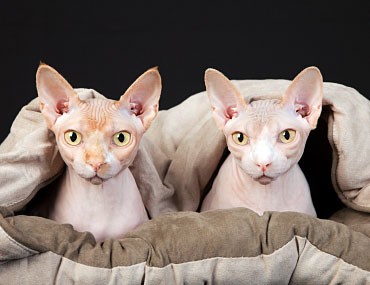History
The origin of this strange looking cat is a bit of a riddle: in 1966, a single hairless kitten named Prune was born. After many failed attempts to create a hairless breed with Prune – many kittens died, the gene pool was limited – female descendants of Prune were bred with another nearly hairless breed, the Devon Rex, as well as with American Shorthair cats. Eventually, the Sphynx breed was established.
There were some early health problems in the breed because of a limited gene pool, but today the breed is very healthy. And while the Sphynx may not be the cuddliest cat breed around, it is one of the most popular cat breeds in America! Cat Facts
Cat Facts
The Sphynx is a pretty interesting breed, and here’s why:
- The Sphynx is not actually hairless, but covered in a coat of down. In fact, the skin texture resembles that of chamois leather.
- They Sphynx likes to keep warm by rubbing up against other animals or people. Because of their lack of hair, they are very warm and soft to the touch.
- Two hairless kittens found in Minnesota in the 1970s had a major influence on establishing the Sphynx breed along with Prune's relatives. Their names? Dermis and Epidermis.
- An adult Sphynx weighs between 6 and 12 pounds
What are they like?
You might hesitate to cuddle with a Sphynx, but a Sphynx won’t hesitate to cuddle with you! Soft like chamois leather, you’ll soon find the Sphynx’s big ears and wide lemon eyes irresistible. That’s because the Sphynx is one of the friendliest breeds around. They crave attention from their owners and aren’t aloof like other cats. A Sphynx is likely to follow you around, rub up against you, meet and greet other pets and people, and explore indoors and out. A particularly intelligent breed of cat, the Sphynx is also very energetic and loves to seek out adventures around the house.
While the Sphynx is a relatively healthy breed, there are some breed-specific health issues to know about:
- Respiratory issues in kittens due to lack of hair
- Hypertrophic cardiomyopathy, a form of heart disease
- Hereditary myopathy, affecting muscle function
- Sensitive digestive systems
Right for you?
Obviously, living in Alaska, Siberia, or anywhere else with a primarily cold climate does not make you a great candidate to welcome a Sphynx into your home. But what else should you consider? Here are some tips:
- Yes, the Sphynx is mostly hairless. But no, the Sphynx is not hypoallergenic. If you have allergies, these cats can make them worse because they produce dander, or dead skin cells.
- Believe it or not, the Sphynx requires regular grooming. Body oils build up on the skin – on other cats these oils are absorbed by the fur – so the Sphynx needs regular baths.
- Sunburns! You’ll have to be careful letting a Sphynx outside – because of the lack of fur, the breed easily sunburns. It is best not to leave a Sphynx outside for long periods of time.
- The Sphynx craves attention. If you have to be away for work a lot, it’s a good idea to get two cats so that they can keep one another entertained.
If you have any questions or concerns, you should always visit or call your veterinarian – they are your best resource to ensure the health and well-being of your pets.
